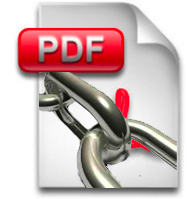 Use PDF files to improve your site’s landing page rankings with Google
Use PDF files to improve your site’s landing page rankings with Google
Help build your niche brand with this eight-step link-building technique
For Internet users of every age, there’s something about document ownership that implies higher value than the same content published on a web page.
We intrinsically perceive content that we can download and own to have more value, like the Kindle or PDF (Portable Document Format) books we buy and download from Amazon and hundreds of other online bookstores.
This creates an opportunity — a link-building loophole — that you can use to improve your site’s landing page rankings with Google and other search engines.
Here’s the simple procedure for using PDF files to create more links:
1. Create a valuable, informative white paper and save it as a PDF file using Adobe Acrobat or another PDF file creation tool.
2. Create a keyword-optimized Rapid Conversion Landing Page (RCLP) filled with mouth-watering benefits and features that describe the report.
3. Upload the document to your website behind the RCLP that offers the report as a free download for new users who sign up for your email newsletter (a free on free offer).
4. Send an announcement about the free white paper to your entire subscriber file using one of your regular email newsletter or promotion spots. Encourage your existing subscribers to both download the report and recommend it to their colleagues (viral marketing).
5. Write a SEO’d press release that describes the free downloadable white paper and includes a hypertext link to the RCLP. Post it on your website.
6. Email a personal note about the new white paper plus the official press release to online publishing colleagues who are predisposed to recommend your free white paper. Urge them to link to your RCLP (Rapid Conversion Landing Page).
7, Post the very same press release on the top press release websites to gain some immediate inbound links and gain a larger audience for your white paper announcement.
8. Use your Facebook, Twitter and LinkedIn social networks to spread the word about your cool, new “free report.” (Note: While it’s not always the best “netiquette” to do commercial posts, promoting a “free report” is generally acceptable.)
Within only a few days you could have dozens of incoming links from other websites, resulting in hundreds of downloads, a significantly larger subscriber file, and eventually, higher search engine rankings.
[text_ad]
The foolish mistake many online publishers make
Most publishers are notoriously shortsighted about step #4 above — using one of their regularly scheduled email blasts to promote your own free report.
For reasons that defy my understanding, they don’t recognize the real value of their own list. The fact is that many of the people most likely to write about and endorse their new free white paper are their email subscribers.
Why are so many publishers reluctant to use one of their “broadcast” slots to promote a free report? The usual reason is that most are unwilling to give up their inventory to build their own circulation.
If you look at the metrics, this attitude is tragically short-sighted and self-defeating.
Why do TV networks use up to 20 percent of their advertising inventory (commercial broadcast time slots) to promote their own televisions programs?
Because the result is much more than a 20 percent increase in viewers for the programs that are promoted. The result is a better return on investment.
That’s a winning economic formula. The networks use some of their advertising inventory to promote their own programs because they make more money. You could do the same.
The best use of the first 10 to 20 percent of your advertising inventory is to promote your own free email newsletter and the white papers described n the above process. This is a Mequoda best practice, yet few online publishers comply.
At Mequoda Daily, every other Friday is circulation promotion day, so we are using just 10 percent of our inventory to promote our own free reports and increase our email circulation.
Of course, Mequoda is a relatively small operation. At present, we have only seven free white papers, but this is changing.
We have set a goal of publishing one new free white paper each month. In fact, Mequoda Daily Editor Amanda MacArthur released a new white paper just last Friday.
We have proven that every time we release a free white paper, Mequoda Daily experiences a significant increase in email circulation.
Bottom line: To get more incoming links, simply publish more great content. To further grow your subscriber file, simply promote free reports to your list.
Have you downloaded these free Mequoda white papers?
- 10 Email Design Best Practices
- Million Dollar Landing Page Templates
- 5 Deadly Membership Website Mistakes
- Blogging for Marketing 101
- Internet Business Models and Strategies
- SEO Copywriting Secrets
- Seven Online Publishing Secrets
Want to learn more about how to grow your email subscriber file… how to build more incoming links… how to achieve higher search engine rankings… how to make more money online?
Join Kim, Amanda and me at the Mequoda Summit to discover the strategies, tactics and best practices for growing a successful online business using the Mequoda System in a Web 2.0 world.
Time is running out. Register for the Mequoda Summit today.


